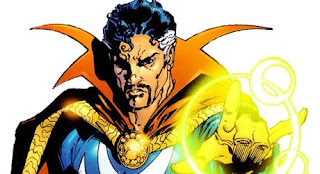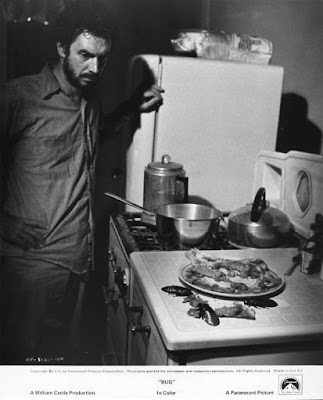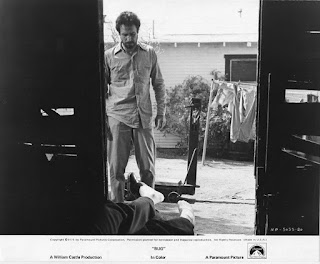As the 1950s progressed and the proliferation of television had studios cutting their B-Units to offset the loss of plunging ticket sales, the Western kinda dried up, leaving the genre a parched tumbleweed of its former self. But, irony of irony, when they started flourishing and became the dominant force on TV, studios started warming up to them again, giving them bigger budgets, adult themes, and a sense of spectacle that you couldn't get on the boob-tube, promoting the Western to, essentially, A-Picture status.
Now, before Sergio Leone and the Italians really blew things up in the 1960s, American westerns were already re-envisioning themselves thanks to the efforts of folks like Andre de Toth and Budd Boetticher (both working with a revitalized Randolph Scott), Jack Arnold (known mostly for his creature features but he made some excellent westerns with Audie Murphy, too,) and, especially, Anthony Mann. In fact, I'll argue with anyone that Leone borrowed liberally from all those mentioned above for his famous Spaghetti Westerns.
For his part Mann brought a stark and brutal film noir flavor to his westerns, and sucked all the romanticism out of the stock characters, situations and landscapes. The heroes were flawed, the villains irredeemably vile, and the heroines were a different kind of damaged goods. And together with star Jimmy Stewart, Mann blazed a trail of box-office hits, beginning with the excellent Winchester '73 (1950) and ended with The Man from Laramie (1955).
One of cinema's great mysteries is the exact reason why Mann and Stewart split-ways (politics most likely), but this rift found Gary Cooper in the starring void in Man of the West (1956), perhaps Mann's most destructive deconstructive western yet. I've always found Cooper to be a bit of an eccentric as an actor, but all of his tics and quirks fit reformed outlaw Link Jones to a tee. Unlike Stewart's characters, who were extremely volatile and extroverted and prone to manic outbursts, Cooper's lone character is introverted and extremely guarded. But what appears to be a bumbling imbecile on the surface is in truth the exact same pressure-cooker with a defective release valve.
And the plot he's plugged into is fairly similar to Clint Eastwood's Unforgiven (1992). Here, bad luck pulls Link back into his old destructive life when a botched train robbery leaves him and two con-artists (O'Connell and London) stranded in the middle of the prairie. Familiar with the area, Link leads them to an old abandoned hideout for shelter only to find it occupied by his old gang, led by the completely psychotic uncle, Doc Tobin (Cobb), who both raised and raised hell with Link before his prodigy got fed up with all the killing, disappeared, and went straight.
And while the other members of the gang don't trust him, Doc tries to bring Link back into the fold for their next big score. Link plays along to protect his two companions as best he can. But things get a little dicey from there with two tough scenes where one outlaw (Lord) forces the girl into a striptease, and then later, Link forces him to do the same after beating the crap out of him. Lord's wounded, humiliated screams as Link tears his clothes off is both deserved and downright disturbing.
This all inevitably leads to a final showdown, and a very disheartening rape, where Link must re-embrace his old ways to both survive and take revenge for the suffering innocents caught up in Tobin's delusional plan of trying to recapture his old thunder. (The big heist is nothing more than an abandoned ghost town.) Needless to say, it is quite spectacular.
The first time I watched Man of the West I'm kinda ashamed to admit that it took me almost half the movie to finally recognize nurse Dixie McCall from TV's Emergency. Born Gayle Peck in Santa Rosa, California, as the legend goes Julie London was discovered by an agent while working as an elevator operator, officially launching her music career and triggering a meteoric rise in the late 1950s that she managed to sustain for the next three decades and 32 albums. Intoning the same kind of sultry and sensual tones as Keely Smith, London also brought a breezy, preternatural intimacy to her songs that just melted your brain like hot caramel over ice cream. (Just listen to her cover of "One for My Baby" if you don't believe me.) Along the way she married and (amicably) divorced fellow jazz-enthusiast Jack Webb, and then married musician (and collaborator and future co-star) Bobby Troup.
And while rightfully known for her music and small screen career, London did make a few appearances on the big screen; but none had more impact than her work as Billie Ellis in Man of the West. Her character goes through all kinds of hell and her relationship with Link is lot more complex than one usually finds in a traditional oater. Before, any dastardly doing to any female was told through the prism of the hero and how it affected them, not the victim herself. Billie is raped by Tobin as a way to get at Link, but Link, while enraged over this, knows she was violated, not him. And rarest of all, Billie, no saint to begin with, and now a rape victim, damaged goods to the civilized world and beyond redemption, manages to survive without being "morally" put down for her sins. She loves Link, but he's already married and lets her down gently. And together, these two ride off into the sunset, bent and twisted but still unbroken.
Between Ellis' pleading, Beasley's grovelling, Tobin's ranting, Coaley's screeching, and Trout's murder of the terrified peasant woman followed by his own howling death, this film tends to haunt the viewer. And yet even though Mann's version of the west is bleak and unforgiving, there is some hope for law and order in Man of the West; as it's clear the time of outlaws like Tobin and his goons is waning, pushed deeper into the rapidly disappearing wilderness or brought to justice by men forged over the same furnace like Link. For in the end, no matter who you are or who you were, there's a choice to be made. One of the answers is right. The other wrong. And the space in-between is kinda blurry.
X
"One of cinema's harshest portrayals of the west, [Man of the West] contains psychotic killers who are total opposites of the romanticized bad men of countless other westerns, a morally ambiguous hero who yields to his long-held-in-check violent nature in order to do in his brutal kin, and a very liberal dose of sex, an ingredient never found in a television western ... Mann typically sets his final gun battles far away from civilization, off in the wilderness, away from all eyes, where both men can fight as unfairly as possible to win -- life and death battles need not be fairly fought ... As is true of many of Mann's heroes, when Link kills his counterpart, he destroys a part of himself. In Mann's films, killing someone is difficult and not to be taken lightly.X
* * * * * * * * * * * * * * * * * * * * * * * * * * * * * * * * * * * * * * * * * * * *
The Fine Print: Man of the West was watched via MGM's DVD. What's the Cult Movie Project? That's 13 down, with 187 more to go.
Man of the West (1958) Ashton Productions :: Walter Mirisch Productions :: United Artists / P: Walter Mirisch / D: Anthony Mann / W: Reginald Rose, Will C. Brown (novel) / C: Ernest Haller / E: Richard V. Heermance / M: Leigh Harline / S: Gary Cooper, Julie London, Lee J. Cobb, Arthur O'Connell, Jack Lord, John Dehner, Royal Dano, Robert J. Wilke
























































